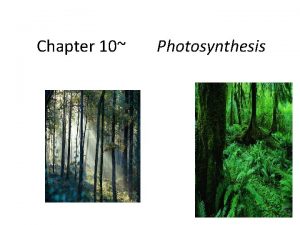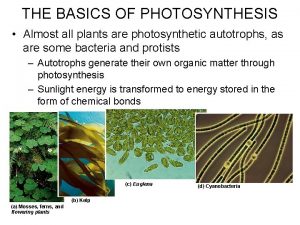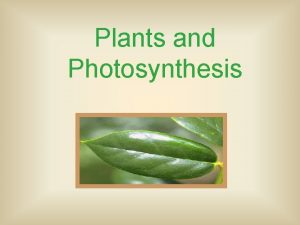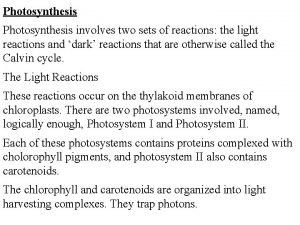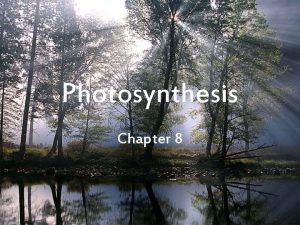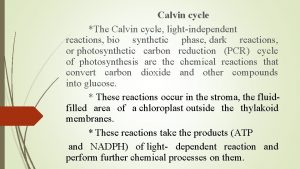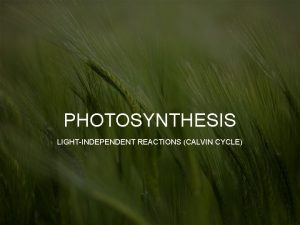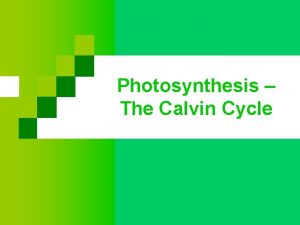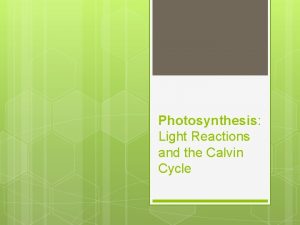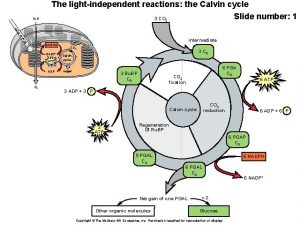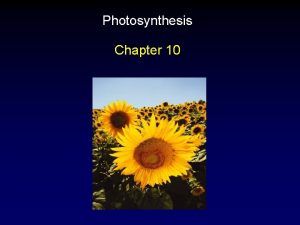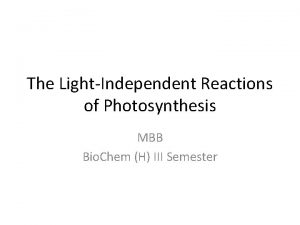CALVIN CYCLE LIGHTINDEPENDENT REACTIONS PHOTOSYNTHESIS So far we








- Slides: 8

CALVIN CYCLE LIGHT-INDEPENDENT REACTIONS

PHOTOSYNTHESIS • So far we have looked at how photoautotrophs use light energy to excite electrons, and in conjunction with H 2 O they produce O 2, ATP, and NADPH • Now we look at how NADPH and ATP are utilized

THE CALVIN CYCLE • Who are the players? • • CO 2 NADPH ATP C 6 H 12 O 6 • The Calvin Cycle has 3 phases that takes CO 2 and uses ATP and NADPH to form glucose

PHASE 1 – CARBON FIXATION Ribulose-1, 5 -biphosphate 3 -Phosphoglyceric Acid • Carbon fixation = conversion from inorganic to organic • CO 2 (inorganic) enters the stroma through stoma openings and begins the cycle by reacting with Ru. BP (rubisco catalyst) to form 2 3 -PGA (organic) • Called “C 3 Metabolism” – taking a 5 carbon molecule and forming two 3 carbon molecules

PHASE 2 - REDUCTION • This phase requires a lot of energy which is provided by the ATP and NADPH we produced during light-dependent reactions • 3 -Phosphoglyceric Acid has an additional phosphate added by hydrolysis of ATP • After Phosphate is added it is reduced using the electrons from NADPH to form Glyceraldehyde 3 -phosphate • 1 of the G 3 P exits the cycle and is used to form Glucose

PHASE 3 - REGENERATION • The other 5 G 3 P are rearranged using ATP to reform Ru. BP • NOTE: don’t let the values in these pictures mislead you… in reality it takes 3 cycles of the calvin cycle to produce one extra G 3 P to be used to form glucose

THE COMPLETE CALVIN CYCLE REMEMBER: each turn of the cycle produces an extra carbon when G 3 P is converted to Ru. BP; this is why it takes 3 turns to form 1 usable G 3 P for Glucose

OTHER THINGS YOU NEED TO KNOW 1. This process goes from a fully oxidized carbon molecule to a highly reduced glucose molecule – endergonic 2. Rubisco (ribulose 1, 5 -biphosphate carboxylase oxygenase) – most important protein/enzyme in the biosphere: provides majority of the worlds organic carbon 3. Plants use G 3 P and reverse-process glycolysis to produce glucose and other simple sugars
